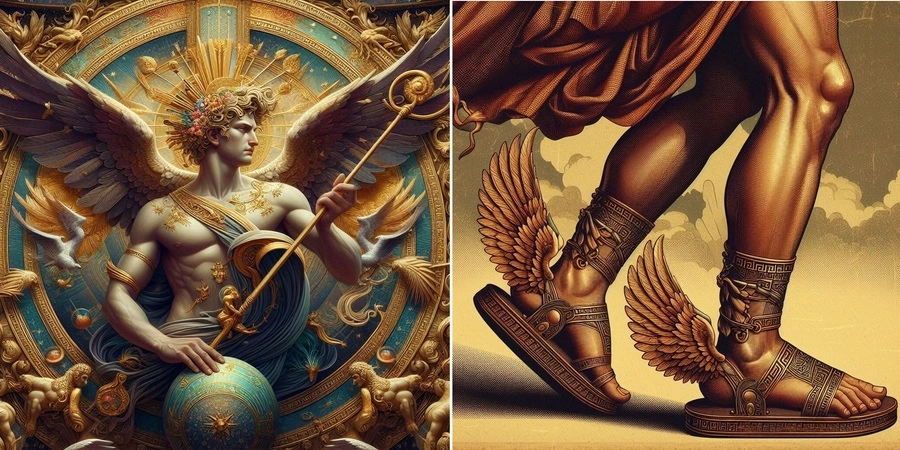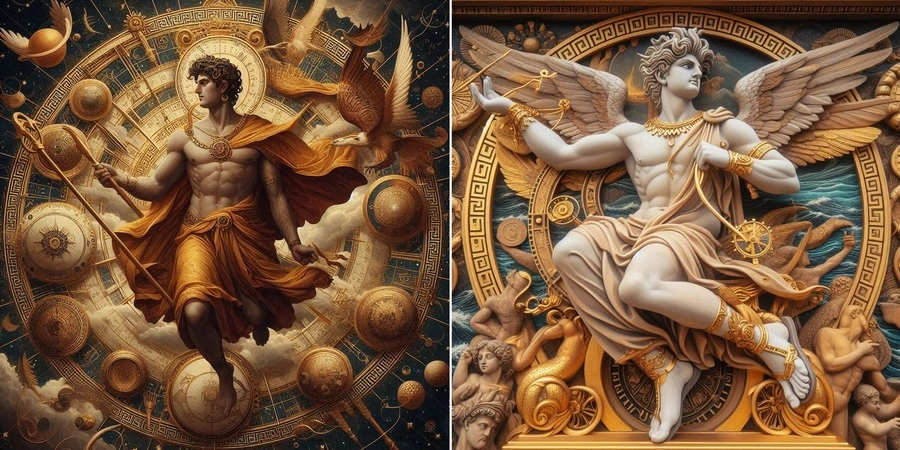
Hermes is one of the most well-known and revered gods in Greek mythology. As the god of commerce, thieves, travelers, and communication, he held a special place in the hearts and minds of the ancient Greeks. He was one of the twelve Olympian gods.
Who was Hermes?
Hermes, son of Zeus and Maia, was born in a secluded cave on Mount Cyllene in Arcadia. From his infancy, he displayed remarkable agility and cunning, traits that would define his role as the divine herald and protector of merchants. His association with trade and commerce is deeply rooted in the ancient Greek worldview, where commerce was seen as a vital link between city-states, fostering alliances and cultural exchange.
Beyond his celestial duties, Hermes was also a guardian of travelers and wayfarers. His benevolence extended to those embarking on perilous journeys, offering them protection and guidance along unknown paths. This aspect of his persona highlights his broader role as a deity concerned with safe passage and the facilitation of connections between distant places and peoples.

In the realm of commerce, Hermes presided over more than mere transactions. He embodied the principles of fair exchange and reciprocity, which were foundational to Greek economic and social life. Merchants and traders invoked his favor before embarking on ventures, seeking not only material gain but also the blessings of smooth transactions and profitable outcomes.
Story about Hermes
According to legend, Hermes was a mischievous child who loved to play pranks on the other gods and mortals. One of his most famous exploits involved stealing Apollo’s cattle, which he then hid in a nearby cave. When Apollo discovered the theft, he demanded that Hermes return the cattle to him. Hermes agreed, but only after he had managed to charm Apollo with his wit and cunning.
As he grew older, Hermes became known for his skill as a messenger and communicator. He was said to be able to speak in many languages, and he often acted as a mediator between the gods and mortals. He was also revered for his ability to guide travelers on their journeys, and he was often depicted with a winged cap and sandals that allowed him to move quickly across great distances.
Family of Hermes
Hermes’ siblings within the Olympian family further illustrate the complexities of divine relationships. As the half-brother of gods such as Apollo, Artemis, Athena, and Dionysus, Hermes occupies a dynamic position among his peers. His interactions with these siblings often reflect both camaraderie and rivalry, showcasing the intricate dynamics within the Olympian hierarchy.
Apollo, in particular, shares a noteworthy relationship with Hermes. As half-brothers, they engage in playful competitions and conflicts that highlight their respective domains—Apollo as the god of music, prophecy, and light, and Hermes as the god of trade, travel, and cunning. Their interactions underscore Hermes’ versatility and adaptability, contrasting with Apollo’s more traditional attributes.
Beyond his immediate family, Hermes’ lineage extends to his own offspring and descendants. Through his union with various nymphs and mortal women, Hermes fathered numerous children who inherited aspects of his divine attributes. These offspring, such as Pan (the god of the wild and shepherds) and Hermaphroditus (a deity associated with androgyny and fertility), embody Hermes’ influence across diverse spheres of Greek mythology.
10 Myths and Facts about Hermes
Hermes, the Greek god of trade, is a fascinating figure in ancient mythology, known for his agility, wit, and multifaceted role as the messenger of the gods and patron of commerce. Over time, numerous myths and beliefs about Hermes have emerged, some accurate and others steeped in misconceptions.
Myths:
- The Lyre-Crafting Thief: As an infant, Hermes displayed his cunning nature. He fashioned a beautiful lyre from a tortoise shell and stole Apollo’s prized cattle. To appease his furious half-brother, Hermes invented the panpipes, showcasing his musical talent and quick thinking.
- A Hundred Knots for Argus: In another myth, Hermes was tasked by Zeus with slaying the hundred-eyed giant Argus, who guarded the nymph Io. Hermes lulled Argus to sleep with enchanting stories, then swiftly beheaded him. The eyes of Argus were then scattered across the tail feathers of a peacock, a creature forever associated with Hermes.
- The Wily Gambler: Hermes wasn’t above a bit of playful trickery. He was known to be a skilled gambler, often using his cunning to win against gods and mortals alike. One myth tells of a dice game with Apollo, where Hermes won a herd of cattle – a clever echo of his earlier bovine escapade.
- The Birth of Athletics: Legend has it that Hermes and his half-brother Ares, the god of war, were engaged in a playful wrestling match. Their energetic bout impressed Zeus, who declared it the first ever athletic competition, with Hermes becoming the patron of athletes and gymnasiums.
- Hermes and the Underworld Chef: In a lesser-known myth, Hermes acted as a mediator between the gods and Asclepius, a demigod renowned for his healing abilities. Asclepius angered Zeus by bringing the dead back to life. Hermes, ever the diplomat, intervened, convincing Zeus to turn Asclepius into the constellation Asclepius, the serpent-bearer.
Facts:
- The Power of the Caduceus: Hermes’ staff, the caduceus, was more than just a walking stick. It was a powerful symbol of communication, negotiation, and sometimes, even trickery. The staff, entwined with two serpents, represented the ability to find common ground and forge agreements, skills essential for a god of trade.
- Hermes, the Shepherd’s Friend: While Hermes is often associated with commerce, he also held the title of protector of flocks and shepherds. This seemingly contradictory role reflects the importance of animal husbandry in ancient Greek society. Shepherds relied on Hermes to keep their animals safe from harm and ensure a successful harvest.
- The Invention of Alphabet Soup (Not Really): While the exact origins of the alphabet remain debated, Hermes was credited with the invention of writing in some Greek myths. He was said to have captured the fleeting thoughts of humans and given them a permanent form through written symbols.
- Hermes and the Crossroads: Hermes wasn’t just the god of travelers; he was the god of crossroads – the liminal spaces where one path diverged from another. His image, often in the form of a stone pillar called a herm, was placed at crossroads as a symbol of guidance and protection for travelers venturing into the unknown.
- Hermes Beyond Greece: The influence of Hermes extended far beyond the Greek world. The Roman god Mercury borrowed heavily from his Greek counterpart, reflecting the importance of trade and travel in both civilizations. Even today, the image of Hermes, the swift and cunning god, continues to inspire artists and storytellers.
The Symbols of Hermes
- The Caduceus: One of the most recognizable symbols of Hermes is the caduceus, a winged staff entwined with two serpents. In ancient Greek mythology, the caduceus symbolized Hermes’ role as a herald and mediator, emphasizing his ability to reconcile conflicts and maintain harmony. This symbol also represented his authority as a messenger of the gods, facilitating communication between Olympus and the mortal world. Over time, the caduceus became associated with commerce and negotiation, highlighting Hermes’ influence in trade and economic transactions.
- Winged Sandals: Hermes is often depicted wearing winged sandals, known as talaria, which enabled him to travel swiftly between the realms of the gods and mortals. These sandals symbolize Hermes’ unparalleled speed and agility, emphasizing his role as the fastest among the Olympian deities. The wings on his sandals not only underscore his divine status but also reflect his ability to transcend physical limitations and traverse vast distances with ease. As a symbol, the winged sandals reinforce Hermes’ association with travel, commerce, and the swift delivery of messages.
- Petasos and Kerykeion: Another distinctive symbol associated with Hermes is the petasos, a traveler’s hat adorned with wings. The petasos symbolizes Hermes’ role as the protector of travelers and wayfarers, offering them guidance and safe passage on their journeys. Additionally, Hermes is often depicted holding a kerykeion, a herald’s staff topped with intertwined serpents and sometimes with wings. This staff symbolizes Hermes’ authority as a messenger and mediator, reinforcing his role as a divine envoy entrusted with delivering messages between gods and mortals.
- Tortoise Shell Lyre: In some depictions, Hermes is shown playing a tortoise shell lyre, an instrument he invented as a child. This lyre symbolizes Hermes’ creative and artistic talents, highlighting his role as a patron of music, poetry, and cultural exchange. The invention of the lyre also showcases Hermes’ resourcefulness and ingenuity, qualities that complement his role as the god of trade and cunning intelligence.
- Ram and Rooster: Animals such as the ram and the rooster are also associated with Hermes in mythology. The ram symbolizes fertility, virility, and the abundance of livestock, aspects that align with Hermes’ broader influence over agriculture and animal husbandry. The rooster, known for its vigilance and crowing at dawn, symbolizes Hermes’ role as a protector and guardian, particularly in warding off evil spirits and ensuring the safety of travelers and merchants.
| The richness of Hermes’ symbols reflects the complexity of the god himself. He wasn’t just a merchant; he was a trickster, a traveler’s guide, and a divine messenger. Each symbol whispers a different aspect of his character, creating a language that transcends mere words. |